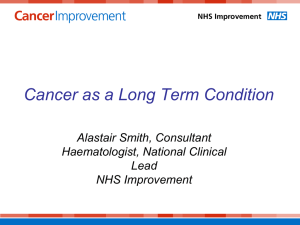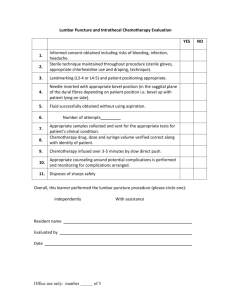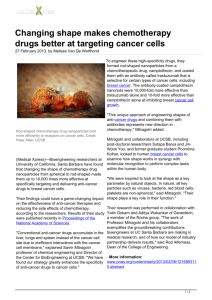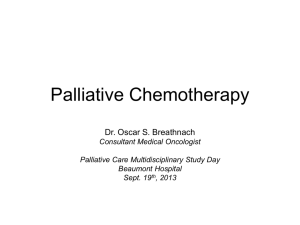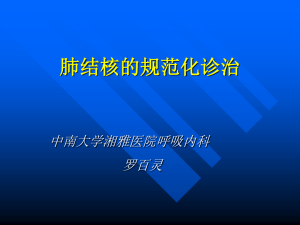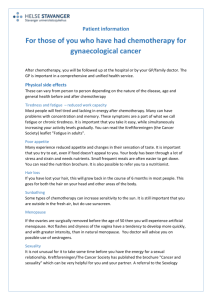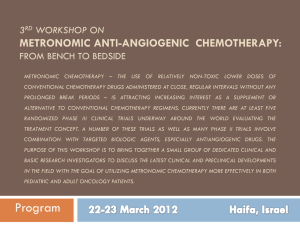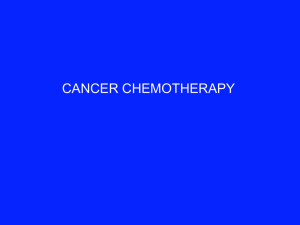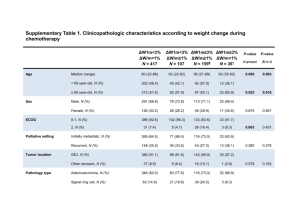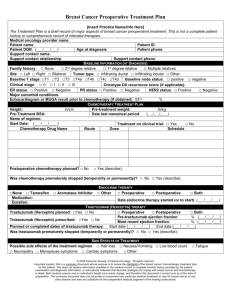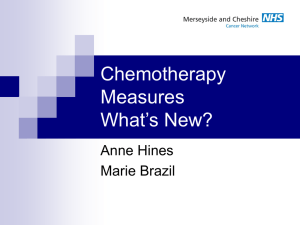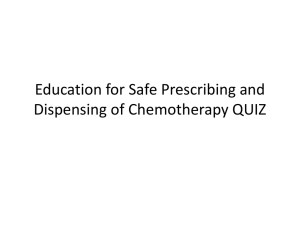the retrospective analysis of gene specific oncotype dx assay in
advertisement
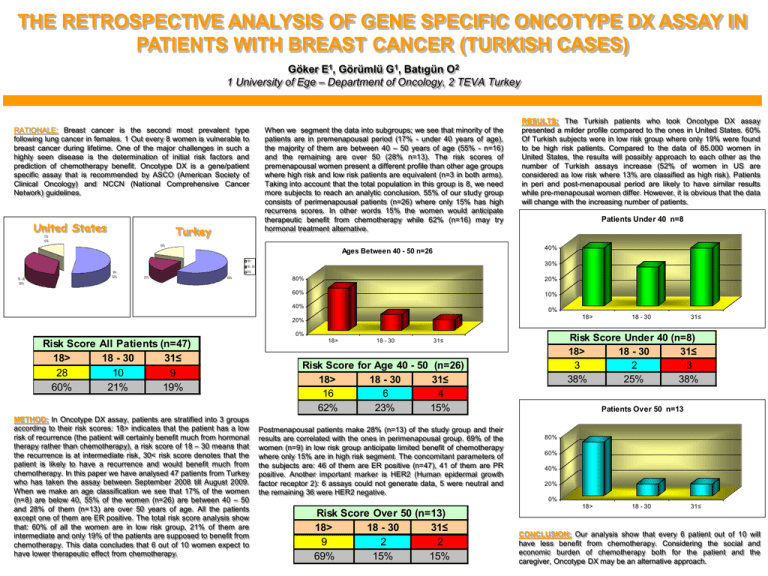
THE RETROSPECTIVE ANALYSIS OF GENE SPECIFIC ONCOTYPE DX ASSAY IN PATIENTS WITH BREAST CANCER (TURKISH CASES) Göker E1, Görümlü G1, Batıgün O2 1 University of Ege – Department of Oncology, 2 TEVA Turkey RATIONALE: Breast cancer is the second most prevalent type following lung cancer in females. 1 Out every 8 women is vulnerable to breast cancer during lifetime. One of the major challenges in such a highly seen disease is the determination of initial risk factors and prediction of chemotherapy benefit. Oncotype DX is a gene/patient specific assay that is recommended by ASCO (American Society of Clinical Oncology) and NCCN (National Comprehensive Cancer Network) guidelines. United States Turkey 31≤ 13% When we segment the data into subgroups; we see that minority of the patients are in premenapousal period (17% - under 40 years of age), the majority of them are between 40 – 50 years of age (55% - n=16) and the remaining are over 50 (28% n=13). The risk scores of premenapousal women present a different profile than other age groups where high risk and low risk patients are equivalent (n=3 in both arms). Taking into account that the total population in this group is 8, we need more subjects to reach an analytic conclusion. 55% of our study group consists of perimenapousal patients (n=26) where only 15% has high recurrens scores. In other words 15% the women would anticipate therapeutic benefit from chemotherapy while 62% (n=16) may try hormonal treatment alternative. 19% 30% 18 - 30 18> 52% Patients Under 40 n=8 40% Ages Between 40 - 50 n=26 18> 18 - 30 35% RESULTS: The Turkish patients who took Oncotype DX assay presented a milder profile compared to the ones in United States. 60% Of Turkish subjects were in low risk group where only 19% were found to be high risk patients. Compared to the data of 85.000 women in United States, the results will possibly approach to each other as the number of Turkish assays increase (52% of women in US are considered as low risk where 13% are classified as high risk). Patients in peri and post-menapousal period are likely to have similar results while pre-menapousal women differ. However, it is obvious that the data will change with the increasing number of patients. 31≤ 21% 60% 80% 20% 60% 10% 40% 0% 18> 20% 0% Risk Score All Patients (n=47) 18> 18 - 30 31≤ 28 10 9 60% 21% 19% METHOD: In Oncotype DX assay, patients are stratified into 3 groups according to their risk scores: 18> indicates that the patient has a low risk of recurrence (the patient will certainly benefit much from hormonal therapy rather than chemotherapy), a risk score of 18 – 30 means that the recurrence is at intermediate risk, 30< risk score denotes that the patient is likely to have a recurrence and would benefit much from chemotherapy. In this paper we have analysed 47 patients from Turkey who has taken the assay between September 2008 till August 2009. When we make an age classification we see that 17% of the women (n=8) are below 40, 55% of the women (n=26) are between 40 – 50 and 28% of them (n=13) are over 50 years of age. All the patients except one of them are ER positive. The total risk score analysis show that: 60% of all the women are in low risk group, 21% of them are intermediate and only 19% of the patients are supposed to benefit from chemotherapy. This data concludes that 6 out of 10 women expect to have lower therapeutic effect from chemotherapy. 18> 18 - 30 31≤ Risk Score Under 40 (n=8) 18> 18 - 30 31≤ 3 2 3 38% 25% 38% 31≤ Risk Score for Age 40 - 50 (n=26) 18> 18 - 30 31≤ 16 6 4 62% 23% 15% Postmenapousal patients make 28% (n=13) of the study group and their results are correlated with the ones in perimenapousal group. 69% of the women (n=9) in low risk group anticipate limited benefit of chemotherapy where only 15% are in high risk segment. The concomitant parameters of the subjects are: 46 of them are ER positive (n=47), 41 of them are PR positive. Another important marker is HER2 (Human epidermal growth factor receptor 2): 6 assays could not generate data, 5 were neutral and the remaining 36 were HER2 negative. 18 - 30 Patients Over 50 n=13 80% 60% 40% 20% 0% Risk Score Over 50 (n=13) 18> 18 - 30 31≤ 9 2 2 69% 15% 15% 18> 18 - 30 31≤ CONCLUSION: Our analysis show that every 6 patient out of 10 will have less benefit from chemotherapy. Considering the social and economic burden of chemotherapy both for the patient and the caregiver, Oncotype DX may be an alternative approach.
